Kelly Wearstler: the woman who brought West Coast style to the world
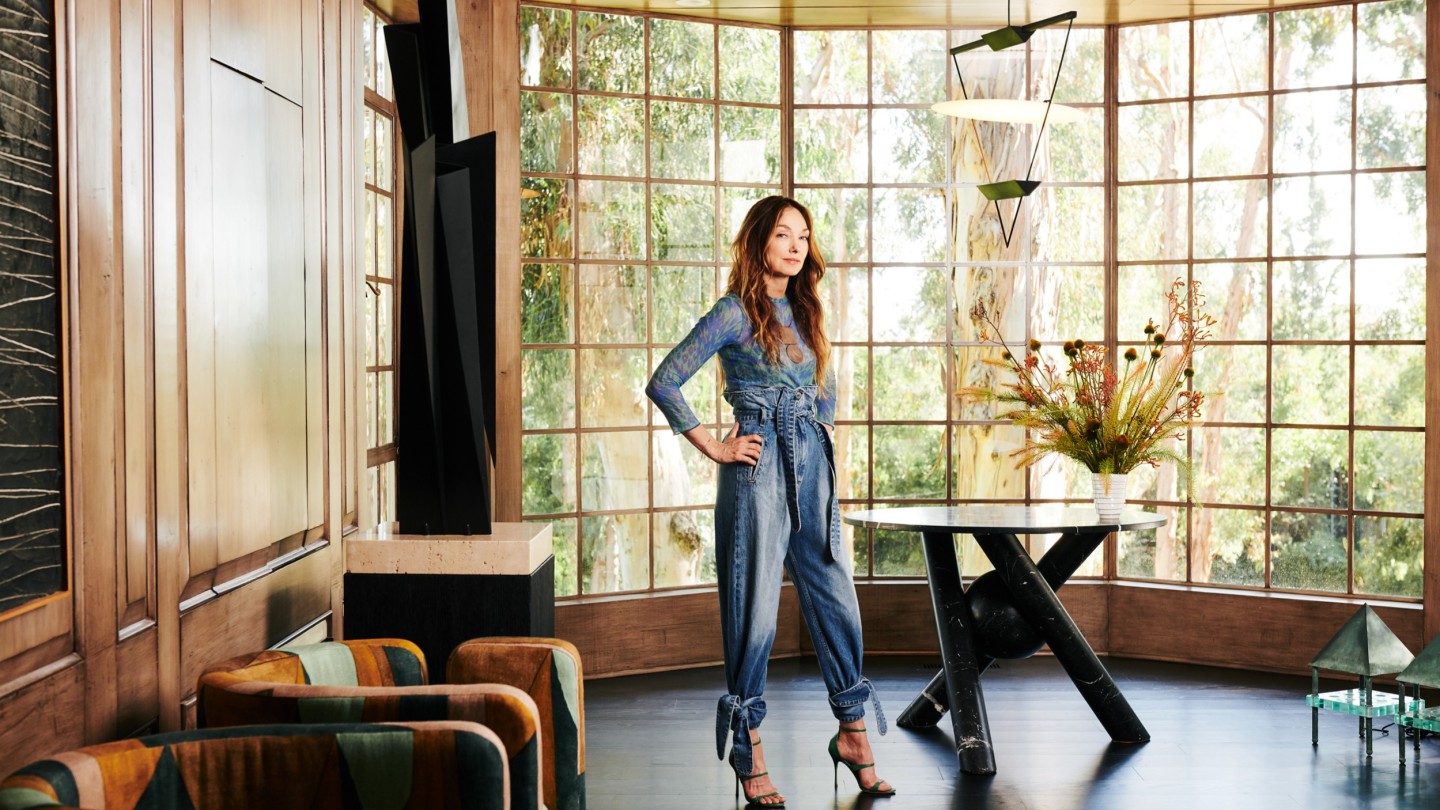
Roula Khalaf, Editor of the FT, selects her favourite stories in this weekly newsletter.
Kelly Wearstler is seriously jet-lagged. Her flight from Japan landed at LAX in the early hours and she’s already hard at work with her team of 50 in her 6,000sq ft studio, housed in a 1960s Craig Ellwood modernist building in West Hollywood. It is not a remarkable day. “I’ve flown to Hong Kong for a three-hour meeting many times and got straight back on the plane home,” she recalls.
To say Wearstler – a creator of textiles, furniture and sculpture as well as commercial and private interior projects – is busy is an understatement. When we meet she’s about to publish her fifth monograph (Evocative Style, Rizzoli), has just unveiled a new tiling range with Ann Sacks, and has more than 100 pieces of furniture in production, which she extends with launches twice a year. Her lighting business alone has reached sales of $40m a year since it was established only three years ago.
And the Wearstler brand is diversifying – fans can select a sofa, such as her Durant 96" design with its bold striped upholstery, for $18,780, or send one of 100 Wearstler-designed Paperless Post invitations to a friend by email for less than 20p a shot.
Wearstler’s work shares something of the lambent spirit that is palpable in David Hockney’s blue pool paintings of the 1960s and the Spanish Colonial Revival chalet homes of the Hollywood Hills. All breathe the same air. The designer has honed a kind of luxe aesthetic that speaks of feel-good West Coast American living. But her look is infinitely more detailed, international and complex than a mere creation of expensively furnished rooms framed by views of the Pacific. Hers is an eye that has travelled.
“She confidently mixes a southern California vibe with references as diverse as traditional Japanese art and the Bauhaus to the Memphis movement of the ’80s,” says Stephen Elrod, executive vice-president and creative director of Lee Jofa, which produces an ever-growing range of Wearstler-designed fabrics and wallpapers. “Her singular aesthetic brings bold colour and pattern to modern interiors.”
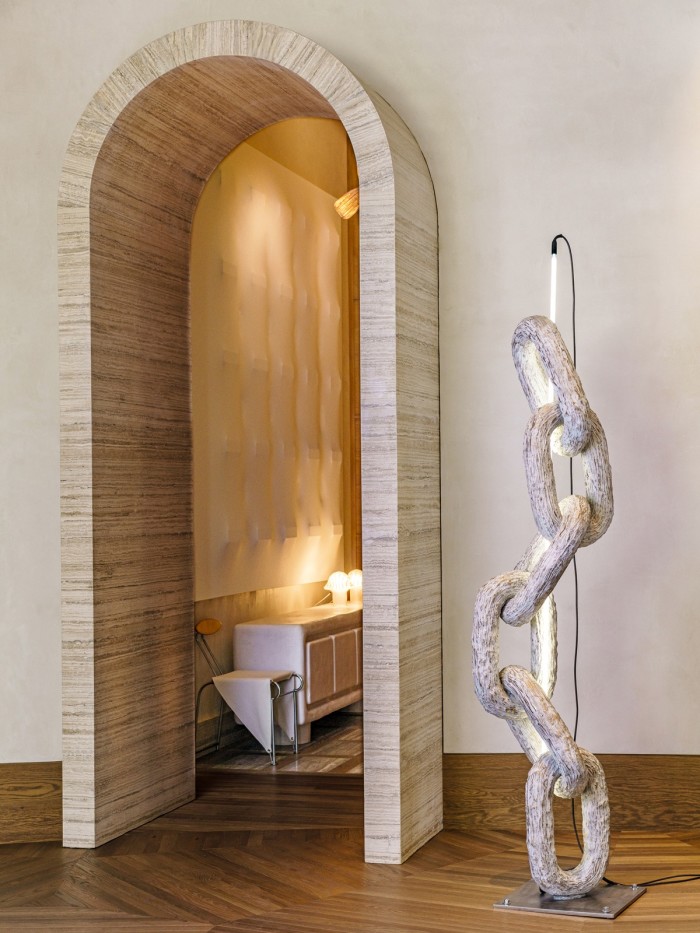
One side of Wearstler’s studio is glass, looking out to a tree-lined elevation of the Hollywood Hills. Giant tables in the middle are covered with drawings, blueprints, patterns, textiles and ephemeral references. This is the hub of the operation. “There’s a little of everything on those tables,” she says. “I find there’s a great synergy having people working in different disciplines side by side. I like that an architect can be inspired by what a graphic or interior designer is doing next to them.”
Wearstler was born in 1967 in Myrtle Beach, South Carolina, and studied on the East Coast – but her business, founded in 1995, has always been based here, on Pacific Time. “I would call myself an American designer,” she says, “but with the mind of a Californian free spirit. Of course, local is now global – you can shop in any country at any given time.”
As part of her sculpture range, she sells the Pacific Surfboard, which is made from Russian birch plywood that is stacked, sanded and sculpted to create a wave-like graphic on the surface. “We worked with a surfboard maker who is a great local artisan,” she says. “He’s also created a plywood credenza in the same way for the new Santa Monica Proper Hotel. It’s so spectacular we’re going to add it to the collection.”
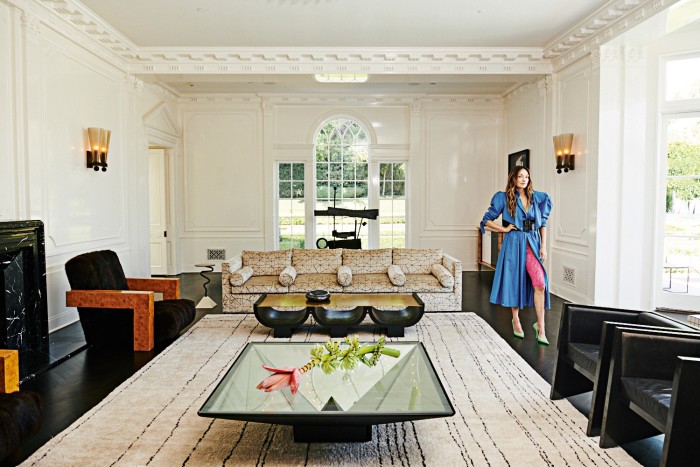
It’s a bold move for any designer to introduce an entire category of pure “sculpture” to their offering, but Wearstler has done it with typical élan. Her monolithic Marble Column and hand-carved solid oak Tephra Column, recalling the great structures supporting temples and palazzos, are designed to elegantly punctuate a large interior. These are not standalone pieces but connect to the rest of her work. “I see everything as sculpture when I design a space,” she says. “It’s about creating a beautiful tension. If there’s a project with lots of curves, my aim is to make them relate to one another, and maybe add one linear table to offset them.”
One of the most recent sculptural pieces to go into production is the Hume Modular Stone Bench, consisting of three elements (which can be selected in five shades of marble) resembling a Roman artefact. “I love versatile pieces,” she says. “This can be a bench, a coffee table, or you can turn it on its side and use it as a pedestal for plants.” Wearstler is meticulous but not precious.
Turn back the clock to 2007 and 2008 and Wearstler was a judge on the American reality TV show Top Design, alongside fellow interiors luminary Jonathan Adler, attracting notice with her distinctive and eclectic style of dress. Each new look that aired was a statement, just as each individual piece of Wearstler furniture grabs the attention now.
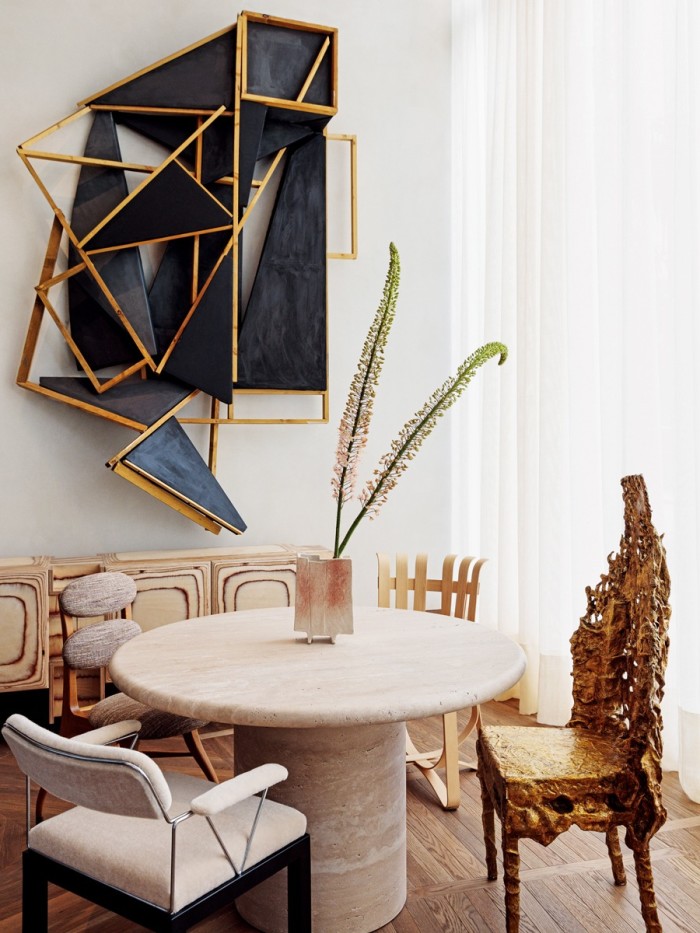
Her Dichotomy Racetrack table certainly turns heads. Its base consists of two pairs of hands set in bronze, creating a design that mixes surrealism with high glamour. In the same way, the chequered facade of her angular Almont credenza is composed of alternating ebonised and natural oak tiles, suggestive of a postmodern take on Giò Ponti. The solid bronze Calia Bronze Draped chair, meanwhile, looks like something Jeff Koons could have conjured by throwing an enchanted sheet of fabric over a dining chair. It’s a striking piece of sculpture that you just happen to be able to sit on.
Since 2017, Wearstler has collaborated with Georg Jensen on a collection, released this year, that fuses Californian energy with Scandinavian chic. The rippled designs of her Frequency series of bowls, vases and lamps might be considered Hollywood Regency if they were cast in bronze, but in stainless steel the Centrepiece and Hurricane candleholder have a cooler edge.
“We talked a lot about nature and how living by the sea inspires an aesthetic shared by California and Denmark,” says Nicholas Manville, chief creative officer of Georg Jensen. Wearstler’s concept proved challenging due to the material’s resistance to being shaped into undulating ribbons, which had to be polished by hand. But the team persevered, pioneering new techniques to achieve her vision. “We learnt from the process,” Manville says.
Wearstler’s world
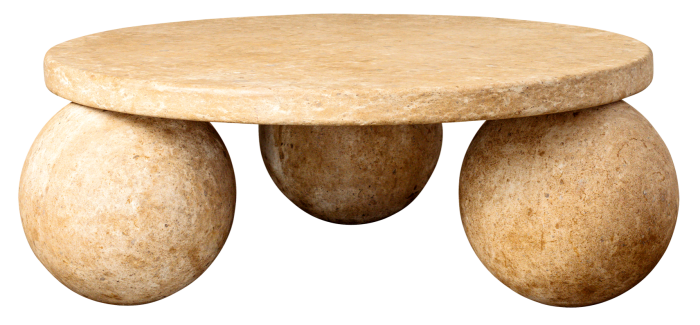
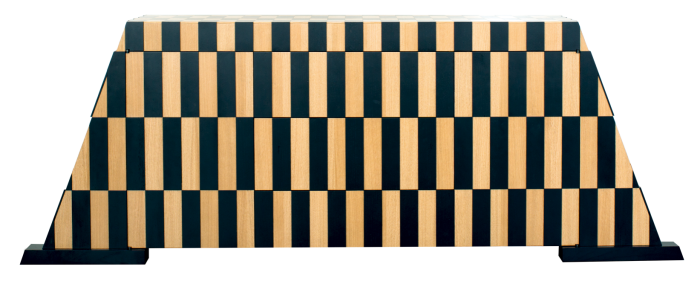
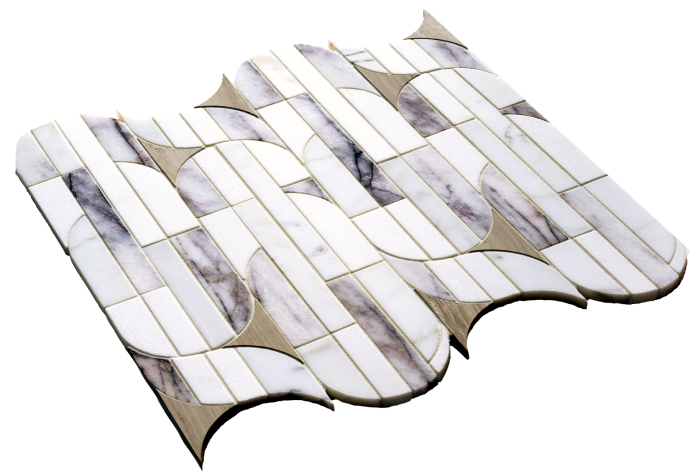

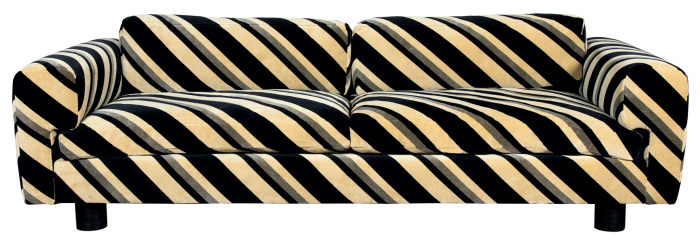
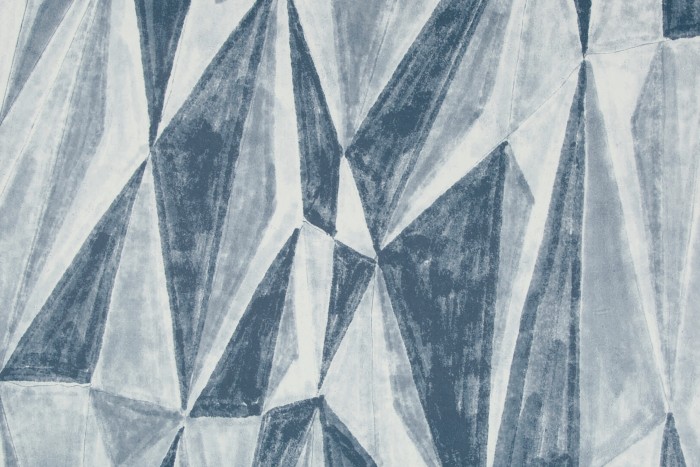
Wearstler’s ability to evoke a sense of place through the use of natural elements has made her the go-to designer for the Proper Hotels brand, for which she currently has projects in LA and Austin. “There’s always something new and interesting that catches your attention when you step inside her curated world,” says Brian De Lowe, co-founder of the hospitality group. “I especially love the hand-carved reception desk – an interpretation of a seashell – that’s in our new Santa Monica hotel, and the oversized nautical chain sculpture in ceramic commissioned from local artist Kelly Lamb. Kelly [Wearstler] doesn’t follow trends, she applies the context of the destination, its architecture, history and cultural surroundings to her interiors.”
For the Santa Monica project Wearstler took her cues from the area’s defining 1920s architecture. “When I visit a hotel, I don’t want to feel I could be anywhere,” she says. “So the LA hotel is about a Spanish revival – it’s a little Mexican, it’s early Californian and there’s an enormous amount of colour and pattern. I wanted it to feel alive and vibrant.”
This bold, graphic approach has become synonymous with the Wearstler aesthetic and underpins collaborations with both The Rug Company and Lee Jofa. The former has produced seven rug collections with the designer since 2008, including the Channels Copper rug, which was created to celebrate the company’s 20th anniversary in 2017 and became a bestseller within a year of its launch. “We often work with fashion and product designers who create work outside of their chosen medium,” says The Rug Company’s co-founder Christopher Sharp. “As an interior designer, Kelly thinks about how everything relates to the surrounding space – and you know it’s going to be great.”
Her design process is exacting. “When we create a rug, we either paint it by hand or create it in Illustrator where the design can be manipulated,” she says. “Then we produce a colour study, try hundreds of different colour combinations, print it on plotting paper, lay it on the floor and bring in chairs and tables to see how furniture reacts with it.” The resulting mastery of scale works fantastically across a variety of designs, from the painterly Edo-style Wake rug to the brightly coloured grid design of Ombre.
The designer will launch her fifth collection of fabrics and wallpapers for Lee Jofa early next year. “There will be new colourways in both fabric and wallpaper for Graffito – one of Kelly’s most successful patterns,” says Elrod, who points to the designer’s insatiable drive to create an element of the unexpected – and fun – as an essential part of the Wearstler MO.
Her new book bears this out, dedicating a chapter to a five-storey beaux-arts townhouse close to Central Park in New York, where the staircase conceals a door leading to a walk-in bar. The doorway is guarded by a pair of Ettore Sottsass Demistella tables. Flicking through the pages, a SoHo loft also stands out. Here, the designer commissioned a hand-painted trompe‑l’oeil wall painting as a backdrop to a switchback staircase, opening up an otherwise cramped space with the feeling of billowing striped fabric. It’s interiors alchemy.
For the limited-edition version of the tome, Wearstler conceived a set of nine “treasures” that open out from it. “We did a project in LA where we skinned all the walls in hand-dyed rice papers and generated a model of that for the book,” she says. “So you can open it out and actually make it, to see how the elevations work.”
While Wearstler’s calling card reads “eclectic”, she constantly references the Bauhaus as an inspiration. “I like it a little more refined,” she admits, “and also love the 1970s and ’80s.” Ettore Sottsass, the designer who shaped the look of the ’80s, is a constant influence, as can be seen in her new Rousseau double boom arm floor lamp, which channels the spirit of Memphis but in luxurious brass, bronze or polished nickel. Similarly, her Covet chandelier might aptly be described as “refined Bauhaus” – its muscular carved alabaster elements set into prongs of bronze.
More integral to the designer’s enduring success, perhaps, is her use of local artisans. This is brought home in the California residence of artist Lana Gomez and her comedian husband Sebastian Maniscalco, where Wearstler commissioned a series of rugs based on Gomez’s work. “She has a knack for incubating art into practical design,” Gomez says. “She has an unbelievable eye, and knew which paintings to choose to become rugs, and which other artists to collaborate with to create one-of-a-kind pieces. There is no plug and chug with her. She doesn’t have a go-to formula. She is a true artist herself.”
Comments